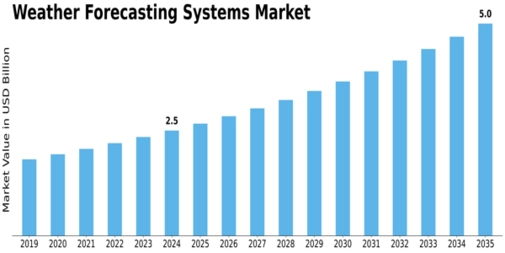Building Resilience: The Role of Weather Forecasting Systems in Risk Reduction

Natural hazards and volatile weather patterns place growing pressure on planners and responders. Robust forecasting systems are central to resilience strategies because they inform preemptive actions rather than just reactive measures.
The Weather Forecasting Systems Market supports this resilience by delivering hazard probability maps, impact projections and lead-time estimates that emergency managers use to stage resources and evacuate at-risk populations. These systems tie atmospheric forecasts to socio-economic exposure data to prioritize responses.
A focused industry analysis highlights how linking forecast outputs with infrastructure models enhances decision clarity. For example, flood forecasts combined with drainage capacity simulations help identify neighborhoods that need preemptive pumping or temporary barriers.
Data fusion is critical: combining hydrological models, land use maps and storm surge estimations produces higher-value guidance. This cross-discipline approach converts meteorological predictions into operational plans for utilities, transport agencies and humanitarian actors.
Real-time situational awareness platforms now integrate live sensor feeds, social media reports and remote sensing to validate and refine forecasts on the fly. Human analysts work with automated triage systems that spotlight anomalies requiring immediate attention.
Education and drills remain important; forecasts are most effective when organizations rehearse responses and assign clear decision authorities. Forecasting systems therefore work best within a culture that emphasizes preparedness and practiced protocols.
Privacy and equitable access are also key concerns. Ensuring that vulnerable communities receive understandable warnings — not just raw data — requires deliberate dissemination strategies and partnerships with local agencies.
As these systems mature, the emphasis will shift to delivering forecast-driven services that reduce economic disruption and human harm through smarter planning and coordinated actions.
FAQs
Q1: How do forecasting systems support emergency response?
A: They provide lead times, impact projections and location-specific guidance that enable staged responses and targeted evacuations.
Q2: What role does data fusion play in resilience?
A: Integrating meteorological data with infrastructure and socio-economic models transforms weather signals into concrete operational plans
- Art
- Causes
- Crafts
- Dance
- Drinks
- Film
- Fitness
- Food
- الألعاب
- Gardening
- Health
- الرئيسية
- Literature
- Music
- Networking
- أخرى
- Party
- Religion
- Shopping
- Sports
- Theater
- Wellness


